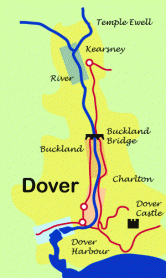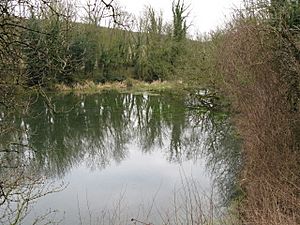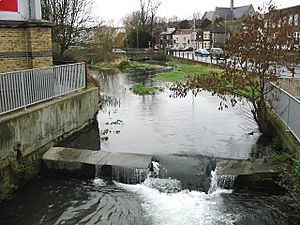River Dour facts for kids
Quick facts for kids River Dour |
|
|---|---|

River Dour within Dover
|
|
| Physical characteristics | |
| Main source | Temple Ewell |
| River mouth | Dover Harbour |
| Length | about 4 miles (6.4 km) |
The River Dour is a cool chalk stream in Kent, England. It starts near the villages of Temple Ewell and River. This river is about 4 miles (6.4 km) long. Today, it flows into Dover Harbour through a special underground tunnel called a culvert.
Contents
The River Dour's History
The River Dour has a long and interesting history. It played a big role in how the town of Dover grew.
Ancient Harbour and Trade
Long ago, the River Dour had a wide estuary (where a river meets the sea). This was where the modern town of Dover is now. This natural harbour was perfect for early settlers and traders. About 3,500 years ago, during the Bronze Age, people used this area for their boats. In 1992, parts of an old Bronze Age boat were found here. You can see it today at the Dover Museum.
Roman Port and Changes
Later, the Dour Estuary became a busy port for the Roman town of Dubris. It was a safe place for the Roman fleet (their navy) to dock. Over time, the river carried a lot of mud and sand, which filled up the harbour. This is called silting up. Because of this, people in the medieval period had to build new, artificial harbours for Dover.
River Dour's Power and Industry
The River Dour has been used for power since the year AD 762. Its flowing water turned many watermills along its path.
Watermills and Their Uses
There were many different types of mills on the Dour.
- Eight of them were corn mills, which ground grain into flour.
- Five were paper mills, which made paper.
One of the oldest corn mills was Buckland Mill. It is now a building with flats. Crabble Mill is a special place. It has been fully fixed up and is now a museum where you can see how corn was milled. The Old Mill in Kearsney is now a private house. Other mills have been changed for different uses.
Other Industries on the River
Besides mills, other businesses used the river's power.
- There were iron foundries, which made things from iron.
- Saw mills, which cut wood, were also here but have been taken down.
- A tannery, which processed animal hides into leather, has also been changed into something else.
Kearsney and the River
The area of Kearsney, Kent is right next to the River Dour. Kearsney Abbey, which used to be a large, grand house, is also found by the river.
The River Dour Trail
The River Dour Trail is a fun walking path. It was created by the White Cliffs Countryside Project. The trail follows the Dour from Temple Ewell all the way to Wellington Dock by the sea. This path is about 4 miles (6 km) long. It usually takes about 2.5 hours to walk the whole trail.



